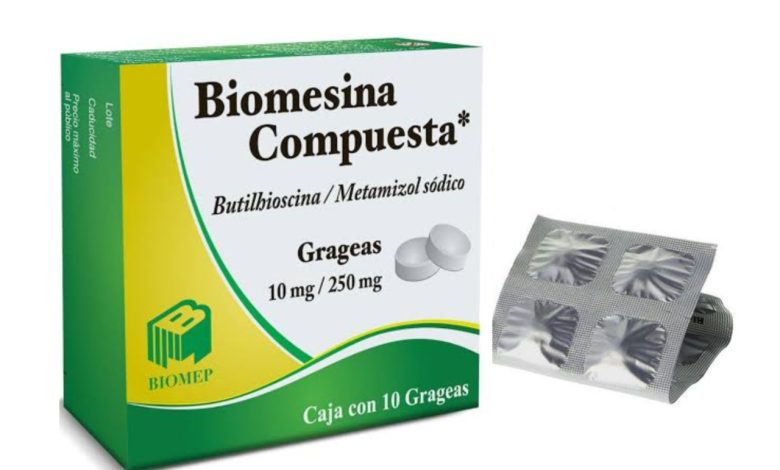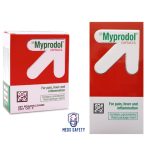Biomesina Compuesta Grageas: Uses, Dosage, Side Effects, Interactions

What is Biomesina Compuesta Grageas?
Biomesina Compuesta Grageas is a combination medication comprised of two active ingredients: Butylhyoscine at a concentration of 10 mg and Metamizole at 250 mg per 10 grageas (coated tablets). This medication is specifically designed to address instances of moderate to intense acute postoperative or post-traumatic pain, as well as moderate to intense colicky pain.
Butylhyoscine, also known as butylscopolamine, operates as a spasmolytic agent targeting the smooth muscles within the gastrointestinal, biliary, and genitourinary tracts. It exerts its therapeutic effects by alleviating spasms without eliciting anticholinergic effects within the central nervous system. This mechanism makes Butylhyoscine an invaluable component in managing various types of pain associated with postoperative or post-traumatic conditions, where muscle spasms often contribute to discomfort and distress.
Complementing the action of Butylhyoscine, Metamizole, a pyrazolone derivative, contributes its analgesic, antipyretic, and additional spasmolytic properties. Metamizole’s analgesic effect is particularly useful in mitigating pain sensations, while its antipyretic action aids in reducing fever, which may accompany postoperative or post-traumatic states. Together, these two active ingredients synergistically alleviate pain and discomfort, offering patients relief from the distressing symptoms associated with their conditions.
The formulation of Biomesina Compuesta Grageas into coated tablets ensures ease of administration and optimal delivery of the active ingredients.
Dosage Instructions
Oral Administration:
• The tablets are to be taken orally with water.
• Swallow the tablets whole without chewing.
Intravenous (IV) or Intramuscular (IM) Administration:
• Reserved for severe cases of spasm with intense pain (e.g., biliary or renal colic).
• Oral forms are preferred for moderate to severe pain of lower intensity.
• Ensure the availability of appropriate equipment for managing rare cases of shock.
• IV injection should be administered slowly (not exceeding 1 mL per minute) with the patient lying down.
• Monitor vital signs including blood pressure, heart rate, and breathing.
• Avoid inadvertent intra-arterial administration to prevent distal vascular necrosis.
• Warm the solution to body temperature before injection.
• Injectable solution may be mixed or diluted with glucose 50 mg/ml (5%), saline 9 mg/ml (0.9%), or lactated Ringer’s solution.
• Administer diluted solution immediately due to its short stability period.
Intramuscular Injection Technique:
• Injection point: Upper quadrant, outside of the buttock.
• Direction: Sagittal and directed towards the iliac crest.
• Depth: Use a needle long enough to ensure the injection reaches the muscle.
Pregnancy
For Biomesina Compuesta, the available data regarding its administration during pregnancy are insufficient to draw definitive conclusions. However, preclinical studies conducted with Hyoscine N-Butylbromide in rats and rabbits did not reveal any embryotoxic or teratogenic effects. Similarly, animal studies investigating metamizole’s passage through the placental barrier found no indications of teratogenic effects.
Despite the absence of direct evidence in humans, caution is warranted. It is recommended to avoid using Biomesina Compuesta during the first trimester of pregnancy due to the lack of sufficient experience. During the second trimester, its use should be considered only when the anticipated benefits clearly outweigh the potential risks.
Although metamizole exhibits only mild inhibition of prostaglandin synthesis, there remains a theoretical concern regarding its effects on the fetus. Potential risks include premature closure of the ductus arteriosus and perinatal complications stemming from decreased platelet aggregation in both the mother and the child. Consequently, Biomesina Compuesta is contraindicated during the third trimester of pregnancy.
It is important to note that while Hyoscine N-Butylbromide and metamizole alone did not demonstrate embryotoxic or teratogenic effects in animal studies, the combined use of these medications during pregnancy requires careful consideration and monitoring due to the lack of human data.
Breastfeeding
Regarding breastfeeding, the safety of Hyoscine N-Butylbromide during lactation has not been definitively established. However, no adverse effects on the neonate have been reported thus far. On the other hand, metabolites of metamizole are excreted in breast milk. While none of these metabolites remain detectable beyond 48 hours post-administration, caution is advised.
Therefore, breastfeeding should be avoided while using metamizole, and for at least 48 hours following its administration, to minimize potential exposure of the nursing infant to the drug and its metabolites. It is crucial for healthcare providers to weigh the potential benefits of treatment against the risks to both the mother and the infant when considering the use of Biomesina Compuesta in lactating individuals. Close monitoring of the infant for any adverse effects is recommended in such cases.
Adverse Reactions
When using Biomesina Compuesta, patients may experience various adverse reactions. Among the potential adverse effects are:
- Hypotension: A decrease in blood pressure may occur, leading to symptoms such as lightheadedness, fainting, or dizziness.
- Dizziness: Patients may experience feelings of dizziness or vertigo, which can affect balance and coordination.
- Dry Mouth: Dry mouth, also known as xerostomia, is a common side effect characterized by a lack of saliva production. This can cause discomfort and difficulty in speaking or swallowing.
It is important for healthcare providers to monitor patients closely for these adverse reactions and provide appropriate management as needed. Patients should also be educated about the potential side effects of Biomesina Compuesta and advised to report any unusual symptoms to their healthcare provider promptly.
Contraindications
Biomesina Compuesta should not be administered in the following cases:
- Hypersensitivity: Patients with known hypersensitivity to pyrazolones, pyrazolidines, or scopolamine butylbromide, including those with a history of agranulocytosis after previous administration.
- Asthma or Analgesic Intolerance: Individuals with asthma triggered by analgesics or intolerance to analgesics, such as urticaria-angioedema type reactions. This includes patients experiencing bronchospasm or other anaphylactoid reactions in response to salicylates, paracetamol, or other non-narcotic analgesics.
- Hematological Disorders: Patients with functional alterations of bone marrow, hematopoietic diseases, or genetic deficiency of glucose-6-phosphate dehydrogenase (G6PDH), as these conditions pose a risk of hemolysis. Additionally, individuals with acute intermittent hepatic porphyria are at risk of porphyria.
- Other Medical Conditions: Contraindications include glaucoma, prostatic hypertrophy with urinary retention, mechanical stenosis of the gastrointestinal tract, paralytic or obstructive ileus, tachycardia, megacolon, and myasthenia gravis.
- Pregnancy and Breastfeeding: Biomesina Compuesta is contraindicated in the third trimester of pregnancy and during breastfeeding.
- Parenteral Route in Children: Parenteral administration of the medication is contraindicated in children under 12 years of age.
- Hypotension and Unstable Circulatory States: The parenteral route is contraindicated in patients with hypotension or unstable circulatory states, as well as in cases of subcutaneous or intra-arterial injection.
- Anticoagulant Therapy: Intramuscular administration is contraindicated in patients receiving anticoagulant therapy due to the risk of intramuscular hematoma, although the intravenous route may be used in such cases.
Warnings and Precautions
Before administering Biomesina Compuesta, healthcare providers should consider the following warnings and precautions:
- Agranulocytosis Risk: Monitor for signs of hematological reactions such as agranulocytosis, aplastic anemia, thrombocytopenia, or pancytopenia. Discontinue treatment if these reactions occur and monitor blood counts closely.
- Anaphylactoid Reactions: Evaluate the risk of anaphylactoid reactions, especially in patients with bronchial asthma, chronic urticaria, or intolerance to alcohol and dyes. Emergency measures should be available, particularly with parenteral use.
- Risk of Shock: There is an increased risk of hypotension with parenteral use, rapid intravenous administration, preexisting arterial hypotension, dehydration, circulatory instability, or insufficiency. Monitoring and prevention strategies are advised to mitigate this risk.
- Elderly Patients and Renal/Hepatic Impairment: Assess the benefit-risk ratio carefully in elderly patients and those with impaired hepatic or renal function.
- Narrow-Angle Glaucoma: Use with caution in patients with undiagnosed narrow-angle glaucoma due to the risk of increasing intraocular pressure.
- Skin Reactions: Discontinue treatment if signs or symptoms of Stevens-Johnson syndrome or toxic epidermal necrolysis appear.
- Gastrointestinal Bleeding: Cases of gastrointestinal bleeding have been reported in patients treated with metamizole.
- Intra-arterial Administration: Avoid inadvertent intra-arterial administration, which may lead to necrosis and potential amputation of the distal vascular area.
Liver and Renal Failure
In patients with liver or renal failure, repeated administration of high doses of Biomesina Compuesta should be avoided. While dose reduction is not necessary for short-term treatments, there is limited experience with prolonged treatments in these patient populations. Close monitoring is advised in such cases.
Interactions of Biomesina Compuesta
When using Biomesina Compuesta, interactions with other medications and substances should be carefully considered. These interactions can affect the efficacy and safety of treatment. Some notable interactions include:
- Potentiation of Anticholinergic Effects: Biomesina Compuesta can enhance the anticholinergic effects of medications such as tricyclic and tetracyclic antidepressants, antihistamines, antipsychotics, quinidine, amantadine, disopyramide, tiotropium, ipratropium, and atropine-like compounds.
- Mutual Reduction of Gastrointestinal Effects: When used with dopaminergic antagonists like metoclopramide, Biomesina Compuesta may reduce gastrointestinal side effects.
- Potentiation of Tachycardic Effects: Biomesina Compuesta can enhance the tachycardic effects of ß-adrenergic medications.
- Altering Effect of Digoxin: The effect of digoxin may be altered when used concomitantly with Biomesina Compuesta.
- Reduction of Plasma Levels: Biomesina Compuesta may reduce the plasma levels of cyclosporine and bupropion. Monitoring is recommended for cyclosporine levels, and caution should be exercised when using bupropion.
- Severe Hypothermia with Chlorpromazine: Concomitant use of Biomesina Compuesta with chlorpromazine may lead to severe hypothermia.
- Synergistic Effect with Alcohol: Biomesina Compuesta may have a synergistic effect with alcohol, potentially increasing its sedative effects.
- Increased Blood Toxicity of Methotrexate: There is an increased risk of blood toxicity with methotrexate when used concurrently with Biomesina Compuesta, especially in elderly patients.
- Caution with Acetylsalicylic Acid: In patients taking low doses of acetylsalicylic acid for cardiac protection, Biomesina Compuesta may decrease the antiplatelet effect of acetylsalicylic acid. Caution is advised in such cases.
- Interaction with Other Medications: Pyrazolones, such as those found in Biomesina Compuesta, may interact with oral anticoagulants, captopril, lithium, and triamterene. Additionally, the effectiveness of antihypertensives and diuretics may be affected by pyrazolones. The extent to which these interactions are caused specifically by metamizole is unclear.
- Laboratory Interference: In diabetic patients, pyrazolone derivatives like those in Biomesina Compuesta may affect enzymatic blood sugar assays using the glucose-oxidase (DOG) method.
Patients should be advised to inform their healthcare provider about all medications, including over-the-counter drugs and supplements, before starting Biomesina Compuesta to prevent potential interactions and ensure safe use. Close monitoring and adjustments in medication dosages may be necessary in cases of concurrent use.





